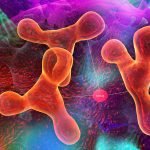Lactoferrin – A Balanced Prebiotic in the Treatment of Dysbiosis
Carrie Louise Daenell, ND
My career-long passion has centered on digestive health, and my favorite new topic in the area of digestion is lactoferrin.
Obviously probiotics promote health in countless ways. It all starts in the digestive system, where probiotics are meant to thrive in abundant numbers in lieu of other competitive and pathogenic organisms. When we fail to achieve this balance, digestive and systemic health challenges ensue. The presence of probiotics in the digestive tract, however, supports their ability to promote health in the face of many disease-related challenges such as constipation, travelers- and antibiotic-induced diarrhea, lactose intolerance, inflammatory bowel diseases, vaginal yeast infections, the influenza virus, rotavirus, hypercholesterolemia, pollen allergies, atopic dermatitis and even cancer (Amenta et al., 2006; McFarland, 2007; Gotz et al., 1979; Gaon et al., 1995; Venturi et al., 1999; Kajander et al., 2005; Hilton et al., 1992; Saavedra et al., 1994; Araki et al., 1999; Agerholm-Larsen et al., 2000; Ziao et al., 2007; Passeron et al., 2006; Gill et al., 2001; Urbancsek et al., 2001). The list goes on.
We all understand the importance of assisting patients in developing and maintaining healthy levels of probiotics in the digestive tract. Supplementation with human probiotic strains that are able to survive exposure to stomach acid as they make their way to the intestines where they belong is our collective starting point. But what else can we do?
Use of Prebiotics
Instinctively we would not only provide the oral supplementation of probiotics, but as NDs we would also want to enhance the environment in which these probiotics are meant to thrive. One of the more direct avenues of support would be to include targeted nutrients to the probiotics, so that they might “live well and prosper.” This form of support is known as a prebiotic (Novak and Katz, 2006). None of this is new to us.
Historically the prebiotic that got most of the press in our profession has been fructooligosacharrides (FOS). FOS is a wonderful “food of choice” for probiotics. In the presence of FOS the patient and clinician can expect to see an exponential level of intestinal population of the quality forms of probiotics administered (Delzenne et al., 2005; Watzl et al., 2005; Guarner, 2005).
However, other organisms feed off of FOS as well. Klebsiellae and other potentially pathogenic organisms, if present in the bowel, may take advantage of this level of support and perpetuate a scenario of dysbiosis (Guarner, 2005).
Lactoferrin may be the alternative and a solution to the so-close and yet so-far-away challenges associated with the use of FOS. Why? Because lactoferrin supports the growth of the beneficial bacteria while at the same time inhibits a broad range of pathogenic bacteria (S. aureus, Listeria, H. pylori, pathogenic E. coli) and viruses (Rotavirus, respiratory syncytial virus, herpes virus and the hepatitis viruses; Fleming, 2001; Johansson, 1960; Kijlstra, 1990; Ward et al., 2005).
About Lactoferrin
Lactoferrin is found in the colostrum component of human milk, and accordingly contributes to the immune benefits commonly associated with a newborn’s ingestion of colostrum during their early stages of breast feeding (Fleming, 2001; Johansson, 1960). It is also one of the constituents of whey protein. A high-quality form of whey protein is well known for its immune supportive effects that exceed those of plant-source proteins. Certainly the presence of lactoferrin may contribute to this phenomenon, as well.
How does lactoferrin provide inhibition of pathogenic organisms? First, lactoferrin strongly binds the iron that some pathogens require for growth, thereby depriving them of their iron source. Lactoferrin has also been shown to signal the immune system to mount a defense; it regulates the migration and maturation of key immune cell defenders, such as T cells, into the area of infection (Legrand et al., 2005). Lactoferrin also inhibits the pathogen’s ability to bind to the intestinal wall, as it is able to bind directly to the organisms (Beeckman, 2007; Stenfors et al., 2001). Your first thought, and rightly so, is “what about iron deficiency anemia?”
Lactoferrin does not interfere with the body’s ability to use iron in support of healthy hemodynamics. In fact, patients suffering from iron deficiency anemia actually do better when supported with lactoferrin than when avoiding it. Further, infant formula manufacturers have figured this out and have added it to their iron-based formulas accordingly. Although the mechanism is not well understood, it is believed that lactoferrin enhances the absorption and utilization of iron across the intestinal membrane (Ward and Conneely, 2004; Paesano et al., 2008). Therefore, one of the most exciting updates to the digestive work that I love to do is to combine the use of high-quality human strains of probiotics with lactoferrin. After all, what is more “tolle causam” than ensuring digestive health?
Lactoferrin, like probiotics, is sensitive to the lower pH acidic environment in the stomach. Nutritional supplements must pass through the stomach in order to get to the intestines where they can be utilized (Lonnerdal and Iyer, 1995; Takeuchi et al., 2006). Therefore, I have found that properly protected forms of probiotics and lactoferrin can be administered in much lower doses with better clinical results. This appeals to my naturopathic priority of “less invasive” whenever possible. For example, a mere 15mg dose of lactoferrin in a form that provides protection from stomach acid is equivalent to a whopping 350mg in an unprotected form. Less really is more! As for the probiotics in lower doses, I have been using digestive stool analysis to analyze the clinical effect of the administration of 6 billion organisms in divided doses per day (seemingly a very low dose) in a form that is protected from exposure to stomach acid. I have found that this lower dose in the protected form performs as well as or better than the much higher doses in the unprotected forms that I used to use. Either way, I am getting the clinical job done for my patients, but I enjoy using less to achieve more.
 Carrie Louise Daenell, ND is a licensed naturopathic physician. Previously the managing editor of the Journal of Naturopathic Medicine, she speaks locally and internationally and writes locally and nationally for physicians and consumer audiences on the topic of natural health. She is a past president of the CANP and has served on the board of directors for the AANP. She is a guest professor in gynecology at SCNM and in rheumatology at Bastyr University. She created the “Carrie Louise Daenell, ND Advanced Gynecology Scholarship” at SCNM. Recently Dr. Daenell co-authored the book Better Breast Health for Life and currently practices as a wellness consultant in the Cherry Creek area of Denver. Areas of specialty include: menopausal, hormonal, digestive, chronic fatigue, allergy, hepatitis, cholesterol, arthritis and immune challenges.
Carrie Louise Daenell, ND is a licensed naturopathic physician. Previously the managing editor of the Journal of Naturopathic Medicine, she speaks locally and internationally and writes locally and nationally for physicians and consumer audiences on the topic of natural health. She is a past president of the CANP and has served on the board of directors for the AANP. She is a guest professor in gynecology at SCNM and in rheumatology at Bastyr University. She created the “Carrie Louise Daenell, ND Advanced Gynecology Scholarship” at SCNM. Recently Dr. Daenell co-authored the book Better Breast Health for Life and currently practices as a wellness consultant in the Cherry Creek area of Denver. Areas of specialty include: menopausal, hormonal, digestive, chronic fatigue, allergy, hepatitis, cholesterol, arthritis and immune challenges.
References
Amenta M et al: Diet and chronic constipation. Benefits of oral supplementation with symbiotic zir fos (Bifidobacterium longum W11 + FOS Actilight), Acta Biomed 77(3):157-62, 2006.
McFarland LV: Meta-analysis of probiotics for the prevention of traveler’s diarrhea, Travel Med Infect Dis 5(2):97-105, 2007.
Gotz V et al: Prophylaxis against ampicillin-associated diarrhea with a lactobacillus preparation Am J Hosp Pharm Jun;36(6):754-7, 1979.
Gaon D et al: Lactose digestion by milk fermented with Lactobacillus acidophilus and Lactobacillus casei of human origin, Medicina (B Aires) 55(3):237-42, 1995.
Venturi A et al: Impact on the composition of the faecal flora by a new probiotic preparation: preliminary data on maintenance treatment of patients with ulcerative colitis, Aliment Pharmacol Ther Aug;13(8):1103-8, 1999.
Kajander K et al: A probiotic mixture alleviates symptoms in irritable bowel syndrome patients: a controlled 6-month intervention, Aliment Pharmacol Ther Sep 1;22(5):387-94, 2005.
Hilton E et al: ingestion of yogurt containing Lactobacillus acidophilus as prophylaxis for candidal vaginitis, Ann Intern Med Mar 1;116(5):353-7, 1992.
Saavedra JM et al: Feeding of Bifidobacterium bifidum and Streptococcus thermophilus to infants in hospital for prevention of diarrhoea and shedding of rotavirus, Lancet Oct 15;344(8929):1046-9, 1994.
Araki K et al: Trial of oral administration of Bifidobacterium breve for the prevention of rotavirus infections, Kansenshogaku Zasshi Apr;73(4):305-10, 1999.
Agerholm-Larsen L et al: The effect of a probiotic milk product on plasma cholesterol: a meta-analysis of short-term intervention studies, Eur J Clin Nutr Nov;54(11):856-60, 2000.
Xiao JZ et al: Clinical efficacy of probiotic Bifidobacterium longum for the treatment of symptoms of Japanese cedar pollen allergy in subjects evaluated in an environmental exposure unit, Allergol Int 56(1):67-75, 2007.
Passeron T et al: Prebiotics and synbiotics: two promising approaches for the treatment of atopic dermatitis in children above 2 years, Allergy Apr;61(4):431-7, 2006.
Gill HS et al: Dietary probiotic supplementation enhances natural killer cell activity in the elderly: an investigation of age-related immunological changes, J Clin Immunol Jul;21(4):264-71, 2001.
Urbancsek H et al: Results of a double-blind, randomized study to evaluate the efficacy and safety of Antibiophilus in patients with radiation-induced diarrhoea, Eur J Gastroenterol Hepatol Apr;13(4):391-6, 2001.
Novak J and Katz JA: Probiotics and prebiotics for gastrointestinal infections, Curr Infect Dis Rep 8(2):103-9, 2006.
Delzenne NM et al: Impact of inulin and oligofructose on gastrointestinal peptides, Br J Nutr 93(Suppl 1):S157-61, 2005.
Watzl B et al: Inulin, oligofructose and immunomodulation, Br J Nutr 93:S49-55, 2005.
Guarner F: Inulin and oligofructose: impact on intestinal diseases and disorders Br J Nutr 93:S61-5, 2005.
Hartemink R et al: Growth of enterobacteria on fructo-oligosaccharides, J Appl Microbiol Sep;83(3):367-74, 1997.
Fleming T (ed): Lactoferrin. In: PDR for Nutritional Supplements. Montvale, 2001, Medical Economics Company, 241-243.
Johansson BG: Isolation of an iron-containing red protein from human milk, Acta Chem Scand 14:510-12, 1960.
Kijlstra A: The role of lactoferrin in the nonspecific immune response on the ocular surface, Reg Immunol 3(4):193-7, 1990-91.
Ward PP et al: Multifunctional roles of lactoferrin: a critical overview, Cell Mol Life Sci Nov;62(22):2540-8, 2005.
Legrand D et al: Lactoferrin: a modulator of immune and inflammatory responses, Cell Mol Life Sci 62(22):2549-2559, 2005.
Beeckman DS et al: Effect of ovotransferrin and lactoferrins on Chlamydophila psittaci adhesion and invasion in HD11 chicken macrophages, Vet Res Sep-Oct;38(5):729-39, 2007.
Stenfors LE et al: Remarkable attachment of lactoferrin to Streptococcus pyogenes during acute pharyngotonsillitis, Acta Otolaryngol Jul;121(5):637-42, 2001.
Ward PP and Conneely OM: Lactoferrin: role in iron homeostasis and host defense against microbial infection, Biometals Jun;17(3):203-8, 2004.
Paesano R et al: The influence of lactoferrin, orally administered, on systemic iron homeostasis in pregnant women suffering of iron deficiency and iron deficiency anaemia, Biochimie Jun 14, 2008.
Lonnerdal B and Iyer S: Lactoferrin: molecular structure and biological function, Annu Rev Nutr 15:93-110, 1995.
Takeuchi T et al: Enteric-formulated lactoferrin was more effectively transported into blood circulation from gastrointestinal tract in adult rats, Exp Physiol Nov;91(6):1033-40, 2006.










